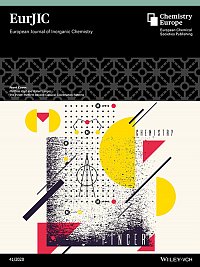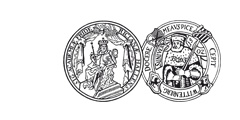Publikationen AG Langer
2025
70. "Optimizing Pore Size and Polarity in Halogen-Functionalized Metal–Organic Frameworks for Efficient Xenon/Krypton Separation: A Synergistic Strategy"; Duo Yue, Rui-Ming Li, Hui-Ting Zheng, Le Yan, Liang Song, Robert Langer, Mihail Barboiu, Zhang-Wen Wei, Cheng-Yong Su, Ji-Jun Jiang; https://pubs.acs.org/doi/10.1021/acsami.5c08672
__________________________________________________________
69. "Hydrogen Borrowing Catalysis for the Modification, Depolymerisation and Synthesis of Polyesters"; F. Rummel, A. Anuar, Afiq, Q. Yu, M. Rohmer, F. Wehmeyer, L. Wogram, M. Vogt, F. Haase, W. Binder, K. Saalwächter, Th. Thurn-Albrecht, R. Langer; Macromolecules 2025; DOI:10.1021/acs.macromol.4c03132
___________________________________________________________
68. "Carbon-Centered Reactivity in Carbodiphosphorane-Based Ligands Allowing for Redox-Non-Innocent Ligand/Ligand Dual Bond-Activation"; Ph. Schatz, W. Xu, S. Rynek, L. Maser, N. Heise, O. Fuhr, D. Fenske, H. Haeri, D. Hinderberger, M. Vogt, R. Langer; https://doi.org/10.1002/anie.202419786
2024
67. "Evidence for a boride–borylene-ligand-tautomerism leading to a
remote C–C-bond and concomitant boryl ligand formation"; F. Wehmeyer, Y. Li, A. Schlossarek, Z. Keb and R. Langer; Dalton Trans, 2024, DOI:10.1039/D4DT02997F
_________________________________________________________
66. "Monomer centred selectivity guidelines in sulfurated ring-opening copolymerisations"; M. R. Stühler, M. Kreische, C. Fornacon-Wood, S. M. Rupf, R. Langer, A. J. Plajer; Chem. Sci. 2024. DOI:10.1039/D4SC05858E
_________________________________________________________
65. "Easy Synthetic Access to High-Melting Sulfurated Copolymers and their Self-Assembling Block Polymers from Phenylisothiocyanate and Oxetane Authors"; J. Stephan, J. L. Olmedo-Martínez, C. Fornacon-Wood, M. Stühler, M. Dimde, D. Braatz, R. Langer, A. J. Müller, H. Schmalz, and A. J. Plajer; Angew. Chem. Int. Ed. 2024, e202405047. https://doi.org/10.1002/anie.202405047
2023
64. "Micellar Catalysis for a Sustainable Hydroaminomethylation Process in Water"; E. Monciatti, F. Migliorini, G. Romagnoli, M. Vogt, R. Langer, M. L. Parisi, and E. Petricci; CS Sustainable Chem. Eng. 2023, 11, 13387-13397. https://doi.org/10.1021/acssuschemeng.3c02983
________________________________________________________
63. "Slow Inversion of Coordinated Thioether Groups in SNS-Type Ruthenium Pincer Complexes"; F. Rummel, F. Wehmeyer, M. Vogt and R. Langer; Eur J Inorg Chem 2023, e202300313 (1 von 6). https://doi.org/10.1002/ejic.202300313
________________________________________________________
62. "Hexacoordinated MIV (M = Ti, Zr, Hf) Tetrachlorido Complexes with Chelating Dithienylethane Based 1,2 Diketone Ligand – π-Conjugation as Decisive Factor for Axial Chirality Mode"; D. Schlüter, D. Duvinage, R. Langer, M. Vogt; Eur J Inorg Chem 2023, e202300276. https://doi.org/10.1002/ejic.202300276

Inside Front Cover
61. "A hampered oxidative addition of pre-coordinated pincer ligands can favour alternative pathways of activation"; F. Wehmeyer and R. Langer; Chem. Comm. 2023, 59, 40, 6004 - 6007. DOI:10.1039/D3CC00874F
________________________________________________________
60. "Switching mechanistic pathways by micellar catalysis: a highly selective rhodium catalyst for the hydroamino-methylation of olefins with anilines in water“; F. Migliorini, E. Monciatti, G. Romagnoli, M. L. Parisi, J. Taubert, M. Vogt, R. Langer*, E. Petricci*, ACS Catal. 2023, 13, 4, 2702–2714.
https://doi.org/10.1021/acscatal.2c06104

Hydroaminomethylation (HAM) is a very straightforward reaction for amine synthesis usually performed in hard reaction conditions and using nonsustainable solvents. The use of micellar and microwave catalysis involves switching from the traditional HAM reaction mechanism to the efficient regioselective synthesis of linear amines. The cover is the result of a collaboration with artist Vanessa Rusci (https://www.vanessa-rusci-arte.com) in the context of a project for scientific dissemination. View the article.
https://pubs.acs.org/toc/accacs/13/4
2022
59. “Mass spectrometric detection of ion pairs containing rigid copper clusters and weakly coordinating counter ions using liquid injection field desorption/ionisation"; J. Taubert, M. Vogt, R. Langer, Eur J Mass Spectrom 2022, 29, 2, 68-74. https://doi.org/10.1177/14690667221139419
________________________________________________________
58. "Manganese(I) Tricarbonyl Complexes with Bidentate Pyridine-Based Actor Ligands – Reversible Binding of CO2 and Benzaldehyde via Cooperative C–C and Mn–O Bond Formation at Ambient Temperature"; R. Stichauer, D. Duvinage, R. Langer, M. Vogt, Organometallics 2022, 41, 19, 2798–2809.
https://doi.org/10.1021/acs.organomet.2c00387
________________________________________________________
57. "Cationic ligands between σ-donation and hydrogen-bridge-bond- stabilisation of ancillary ligands in coinage metal complexes wit protonated carbodiphosphoranes“; M. Maser, M. Vogt, R. Langer, Dalton Trans. 2022, 51, 17397-17404. doi.org/10.1039/D2DT02338E
________________________________________________________
56. "Trigonal Bipyramidal Rhodium(I) Methyl and Phenyl Complexes: Precursors of Oxidative Methyl and Phenyl Radical Generation"; Inorganics 2022, 10 (3), 28; U. Fischbach, M. Vogt, P. Coburger, M. Trincado, H. Grützmacher. https://doi.org/10.3390/inorganics10030028
________________________________________________________
55. "Time-Resolved X-Ray Spectroscopy to Study Luminophores with Relevance for OLEDs"; M. Vogt, G. Smolentsev. ChemPhotoChem 2022, 6, e202100180. https://doi.org/10.1002/cptc.202100180
_________________________________________________________
54. "David Milstein: Shaping Organometallic Catalysis Over Five Decades"; M. Feller, C. Gunanathan, A. Kumar, R. Langer, M. Montag, T. Schaub, M. Vogt, T. Zell; Chemistry Views 06/2022; Copyright: Wiley-VCH GmbH. DOI:10.1002/chemv.202200040
_________________________________________________________
53. "In Celebration of the 80th Birthday of Prof. Dr. Dieter Fenske"; P. W. Roesky, S. Dehnen, K. Merzweiler, U. Radius, R. Langer, and H. Krautscheid; Z. Anorg. Allg. Chem. 2022, 648, e202200268. https://doi.org/10.1002/zaac.202200268
2021
52. "An Organotin Route for the Preparation of 2,6-Bis(diphenylphosphino) bromo-benzene and the Related Bis(Phosphine Oxide). Precursors for Novel Ligands"; F. Meyer, T. Kuzmera, E. Lork, M. Vogt, J. Beckmann; Z. Anorg. Allg. Chem. 2021, 1-7. https://doi.org/10.1002/zaac.202100210
____________________________________________________________
51. "(6-Diphenylphosphinoacenaphth-5-yl)indium and -nickel Compounds: Synthesis, Structure, Transmetalation, and Cross-Coupling Reactions"; S. Furan, M. Vogt, K. Winkels, E. Lork, S. Mebs, E. Hupf, J. Beckmann; Organometallics 2021, 20, 9, 1284–1295. 9, https://doi.org/10.1021/acs.organomet.1c00078
___________________________________________________________
50. "Facial vs. Meridional Coordination Modes in ReI Tricarbonyl Complexes with a Carbodiphosphorane-based Tridentate Ligand"; L. Maser, M. Vogt, R. Langer; Z. Anorg. Allg. Chem. 2021, 647,14. https://doi.org/10.1002/zaac.202100151
![The Cover Picture shows a series of rhenium(I) triscarbonyl complexes with a carbodiphosphorane-based tridentate ligand between two facades of the MLU Weinberg Campus. The [PCP] and [PC(H)P]+ coordination sides in the carbodiphosphorane ligand open a window to versatile coordination modes toward the ReI center. In this context the colored globes, highlighting the large impact of modern pincer chemistry, illustrate the meridional configuration of the carbodiphosphorane pincer-ligand in the reported rhenium complex to be located in the thermodynamic ground floor. Yet a facial arrangement was initially observed upon coordination to ReI, it is located in the upper floors of the building (https://doi.org/10.1002/zaac.202100151).](/im/1626418600_1741_00_200.jpg)
The Cover Picture shows a series of rhenium(I) triscarbonyl complexes with a carbodiphosphorane-based tridentate ligand between two facades of the MLU Weinberg Campus. The [PCP] and [PC(H)P]+ coordination sides in the carbodiphosphorane ligand open a window to versatile coordination modes toward the ReI center. In this context the colored globes, highlighting the large impact of modern pincer chemistry, illustrate the meridional configuration of the carbodiphosphorane pincer-ligand in the reported rhenium complex to be located in the thermodynamic ground floor. Yet a facial arrangement was initially observed upon coordination to ReI, it is located in the upper floors of the building (https://doi.org/10.1002/zaac.202100151).
___________________________________________________________
49. "Rhodium Carbonyl Complexes Featuring Carbodiphosphorane-based Pincer Ligands“; W. Xu, L. Maser, L. Alig, R. Langer; Polyhedron 2021, 196, 115018. https://doi.org/10.1016/j.poly.2020.115018
___________________________________________________________
48. "From carbones to carbenes and ylides in the coordination sphere of iridium“; Y. Li, L. Maser, L. Alig, Z. Ke, R. Langer; Dalton Trans. 2021, 54, 954. DOI:10.1039/d0dt03942j
__________________________________________________________
47. "Flexible Coordination of Carbodiphosphorane-based Pincer Ligands in Chromium(0) Carbonyl Complexes“; L. Maser, P. Korziniowski; R. Langer; Can. J. Chem 2021, 99, 2, 253-258. DOI:10.1139/cjc-2020-0351
2020
46. "Taking a snapshot of the triplet excited state of an OLED organometallic luminophore using X-rays"; Smolentsev, G., Milne, C.J., Guda, A. et al.; Nat Commun, 2020, 11, 2131. DOI:10.1038/s41467-020-15998-z
(Dr. Vogt mit MLU als affiliate)
_______________________________________________________

Cover Picture
Free Access Front Cover:
The Pincer Platform Beyond Classical Coordination Patterns (Eur. J. Inorg. Chem. 41/2020)
Dr. Matthias Vogt, Prof. Dr. Robert Langer
Pages: 3884
First published: 20 October 2020
The Front Cover shows the analogy between the arrangement in pincer-type ligands and simple geometrical compositions, which can easily be deconstructed into their building blocks. Using such a deconstructive approach, the present Minireview categorizes pincer-type ligands according to the binding properties of the involved ligating fragments and reflects achievements beyond well-established definitions. More information can be found in the Minireview by M. Vogt and R. Langer .
________________________________________________________
45. "The Pincer Platform Beyond Classical Coordination Patterns“; M. Vogt, R. Langer; Eur. J. Inorg. Chem., 2020, 3885–3898. https://doi.org/10.1002/ejic.202000513
________________________________________________________
44. "Small Chains of Main Group Elements by BH3-adduct formation of tBu2E-N(H)-EtBu2 (E = P, As)“; M. Fritz, B. Ringler, C. v. Hänisch, R. Langer; Z. Anorg. Allg. Ch, 2020, 992-998. DOI: 10.1002/zaac.202000034
________________________________________________________
43. "Effect of pyrolytic temperature over MOFs templated Cu NPs embedded in N-doped carbon matrix on hydrogenation catalytic activities“; W. Xu. C. Lin, S.-J. Liu, H.-Y. Xie, Y.-X. Qiu, W.-T. Liu, H.-R. Chen, S.-B. Qiu, R. Langer; Inorg. Chem. Commun., 2020, 115, 107859. DOI:10.1016/j.inoche.2020.107859
2019
42. “Lewis Acid Transition Metal Catalyzed Hydrogen Activation: Structure, Mechanism, and Reactivity“; Y. Li, J. Liu, X. Huang, L.-B. Qu, C. Zhao, R. Langer, Z. Ke, Chem. Eur. J. 2019, 25, 13785-13798. DOI:10.1002/chem.201903193
_______________________________________________________
41. “Redox-active, boron-based ligands in iron complexes with inverted hydride reactivity in dehydrogenation catalysis“; A. Bäcker, Y. Li, M. Fritz, M. Grätz, Z. Ke, R. Langer, ACS Catalysis 2019, 9, 8, 7300-7309. DOI:10.1021/acscatal.9b00882
_______________________________________________________
40. “Comparing the Acidity of (R3P)2BH-Based Donor Groups in Iridium Pincer Complexes“; L. Maser, C. Schneider, L. Alig, R. Langer, Inorganics 2019, 7(5), DOI:10.3390/inorganics7050061
_______________________________________________________
39. “Quantifying the Donor Strength of Ligand-Stabilized Main Group Fragments“; L. Maser, C. Schneider, L. Vondung, L. Alig, R. Langer, J. Am. Chem. Soc. 2019, 141, 7596-7604. DOI:10.1021/jacs.9b02598
______________________________________________________
38. “Ligands Based on Phosphine-Stabilized Aluminum(I), Boron(I) and Carbon(0)“; L. Vondung, P. Jerabek, R. Langer, Chem. Eur. J. 2019, 25, 3068-3076. DOI:10.1002/chem.201805123
______________________________________________________
37. “Reactive Dimerization of an N-heterocyclic Plumbylene: CH Activation with PbII“; R. Guthardt, J. Oetzel, J. I. Schweizer, C. Bruhn, R. Langer, M. Maurer, J. Vícha, P. Shestakova, M. C. Holthausen, U. Siemeling, Angew. Chem. Int. Ed. 2019, 58, 1387-1391. DOI:10.1002/anie.201811559
2018
36. "CO2 based hydrogen storage – formic acid dehydrogenation"
T. Zell, R. Langer, Phys. Science Rev. 2018, 3 (12). DOI:10.1515/psr-2017-0012 ; _______________________________________________________
35. "Introduction: hydrogen storage as solution for a changing energy landscape"; T. Zell, R. Langer, Phys. Science Rev., 2018, 4 (1). DOI:10.1515/psr-2017-0009
______________________________________________________
34. "A New Anthraquinoid Ligand for the Iron-catalyzed Hydrosilylation of Carbonyl Compounds at Room Temperature: New Insights and Kinetics"; , Dalton Trans., 2018, 47, 7272-7281. DOI:10.1039/c8dt01123k
______________________________________________________
33. "Carbodiphosphorane-based nickel pincer complexes and their (de)protonated analogues: dimerisation, ligand tautomers and proton affinities"; L. Maser, J. Herritsch, R. Langer, Dalton Trans., 2018, 47, 10544-10552. DOI:10.1039/c7dt04930g
_____________________________________________________
32. "Umpolung at Boron - Ancillary Ligand Induced Formation of Boron-based Donor Ligands from Phosphine-Boranes"; L. Vondung, L. Alig, M. Ballmann, R. Langer, Chem. Eur. J., 2018, 24, 12346 –12353. DOI:10.1002/chem.201705847
______________________________________________________
31. “Ambireactive (R3P)2BH2-groups facilitating temperature-switchable bond activation by an iron complex“; L. Vondung, L. E. Sattler, R. Langer, Chem. Eur. J., 2018, 24, 1358-1364. DOI: 10.1002/chem.201704018
_____________________________________________________
30. "From ruthenium to iron and manganese - a mechanistic view on challenges and design principles of base metal hydrogenation catalysts"
T. Zell, R. Langer, ChemCatChem, 2018, 10, 1930 –1940.
DOI:10.1002/cctc.201701722
______________________________________________________
29. "The ABC in Pincer Chemistry - from Amine- to Borylene- and Carbon-based Pincer-Ligands"; L. Maser, L. Vondung, R. Langer, Polyhedron 2018, 143, 28-42. DOI: 10.1016/j.poly.2017.09.009




